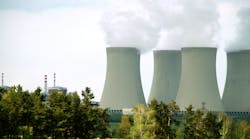Nothing can jolt a modern society more than a threat to its energy security. We saw that in the U.S. in the mid-1970s with OPEC’s oil embargo—and now we’re seeing it in Europe with the shutting off of Russia’s natural gas spigot. Such threats disproportionately affect manufacturers, because the industrial sector consumes more than one-third of energy resources—including natural gas as a feedstock for chemicals and chemical products such as plastics.
Now two crises—the energy threat in Europe and global climate change—have converged to create ideal conditions for the revival of an idea that not too long ago was dead in the water: the reemergence of nuclear energy.
A little history first. When nuclear power plants first came online in the 1960s, they held great promise for cheap, plentiful electricity. According to the Nuclear Energy Institute, one uranium fuel pellet generates as much energy as a ton of coal or 17,000 cubic feet of natural gas, so despite the challenge of toxic waste disposal, the American public was supportive. But a series of crises of varying proportions ultimately moved public opinion in the opposite direction.
Support in America collapsed after 1979’s partial meltdown at Three Mile Island. While the containment was sufficient to protect public health, anxiety among Americans spiraled, spreading to public officials, and dozens of plants that were at some stage of planning—from being on the drawing board to already being in the construction phase—were halted.
As a result, while there are 92 commercial reactors operating in 28 states in the U.S. presently, the average plant is 40 years old. And until Tennessee’s Watts Bar Unit 2 came online in 2016, the last reactor opened in this country was in 1996. The United States’ 55 commercial nuclear plants account for only 19% of this nation’s total electricity generation—61% comes from fossil fuels and 20% comes from renewable energy sources—and, as those reactors start to go offline, the percentage of nuclear power reliance will shrink.
Around the world, not much is different. Globally, fossil fuels still account for the majority of electricity consumption: coal accounts for 37% and natural gas for 25% (though it releases only half the CO2 that coal does). Nuclear, which accounted for 17% of electricity generation in the 1990s, today only accounts for 10% worldwide. The world uses more hydro (16%) and almost as many renewables (8%) as it does nuclear.
After the Tohoku earthquake and the Fukushima Daiichi nuclear disaster of 2011, officials in countries like Japan and Germany opted to completely forego nuclear energy, resulting in the downturn. (Only France has continuously relied on nuclear power, which accounts for more than 70% of that country’s electrical energy generation, the largest proportion of nuclear in the world.)
But Russia’s invasion of Ukraine is the straw that broke the camel’s back. With enormous scientific and political pressure to take serious measures to tackle climate change, governments were already reconsidering nuclear power. Russia’s decision to cut its gas supplies to Germany, its largest customer, has forced the latter’s hand, and the EU’s largest economy is revisiting its nuclear strategy. Japan, too, has reevaluated its plans and opted to bring nine reactors back online to date, with up to 30 restarting in the coming decade.
In other words, nuclear is making a comeback. In fact, according to the World Economic Forum, more than 50 reactors are under construction across the globe. China, whose total GHG emissions equal that of the U.S., India, and the EU combined, has the fastest-growing nuclear program, with 19 reactors being built and plans for more. And others are on drawing boards:
The timing couldn’t be better. The need for plentiful, low-cost energy for electricity will rise dramatically in the coming years as the global middle class continues to expand (that group is expected to number 5.3 billion by 2030). Increased fossil fuel production isn’t compatible with reducing greenhouse gas emissions, and renewables technology isn’t evolving nearly fast enough to support the expected growth in demand. Nuclear energy’s time has come once again.
Of course, nuclear has challenges of its own—the biggest being the overall expense and the almost habitual lengthy delays in getting reactors online. For example, after years of delays, the Vogtle nuclear power plant in the state of Georgia—which should start operating in the coming year—ultimately cost $28 billion, twice what was expected.
These are not easy hurdles to overcome. But considering the state of the world, advocates for nuclear energy are finally getting heard again.











